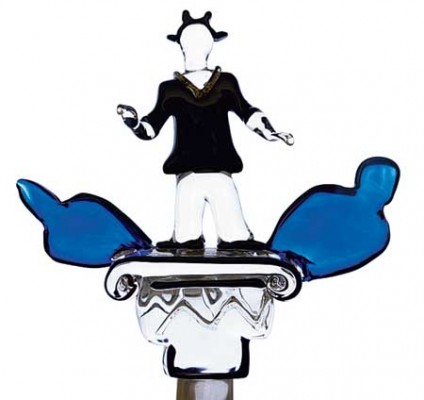Ugo Nespolo – an artist does it ‘his way’
Italian artist Ugo Nespolo combines an insatiable artistic and intellectual appetite with a drive to do things his own way.
Summary
HOMETOWN: Mosso Santa Maria near Biella, Italy.
BIRTHDATE: 29 August 1941.
FAMILY: Married, with two children, Camillo, 19, and Violetta, 15, and Febo, a wire-haired dachshund.
INTERESTS: The world.
FAVOURITE MOVIE: “Impossible to say. Recently I enjoyed Inglourious Basterds. I love Jerry Lewis and can’t understand why he isn’t appreciated for his genius in his own country.”
FAVOURITE BOOK: Catcher in the Rye, by J.D. Salinger.
FAVOURITE ARTIST: “Again, impossible to say. Favourite for what? Some names that come to my mind are Vermeer, Miro, Matisse and Matthias Grünewald.”
Italian artist Ugo Nespolo combines an insatiable artistic and intellectual appetite with a drive to do things his own way.
Singing with Andrea Bocelli, dining with Woody Allen, making a film with Brian de Palma and conversing with Andy Warhol: This takes more than energy and creative talent. It requires an indefatigable 360-degree intellectual curiosity about the world. Italian artist Ugo Nespolo has that curiosity – and has done all these things and more in the course of his 50-year career.
Nespolo received Italy’s prestigious Bolaffi Award in 1974, and his one-man shows have won acclaim in Europe, North and South America and Japan. He is sought out to design opera productions and advertising campaigns, title designs for television and book layouts for publishing firms. Few artists have embraced so many media so enthusiastically, and fewer still have been as warmly embraced by the critics for doing so. Nespolo’s output includes paintings, sculptures in ceramic, glass and bronze, experimental films, furniture and carpet design, theatrical staging and costumes, and advertising posters. His creations have incorporated embroidery, alabaster, ebony, mother-of-pearl, silver and wood inlay.
What’s more, as he proudly tells a visitor to his 4,000-square-metre atelier in the centre of Turin, he did it “his way”. (“My Way”, the Frank Sinatra song, is one of Nespolo’s favourites, and, not incidentally, an Italian retrospective of the artist’s work in 2007 was called “My Way”).
Nespolo’s studio is a three-storey porcelain factory. He has been buying it up piece by piece since the early 1980s and renovating the space his way. The result is colourful, creative and almost infantile in its exuberance. The courtyard entry features a motorcycle decorated and signed by him. The main floor includes an exposition area for his work, similar to a small gallery. The top floor is dedicated to film and has a screening room and a 40-seat auditorium. Nespolo’s office, laboratory and other work areas for ceramics and glass are located on the middle floor. Some of the furniture was designed by him, some by Italian architect and designer Ettore Sottsass. In addition, there are pieces of American furniture from the 1950s (“because I love them!”). His office contains an old American jukebox, a carpet he designed and the flags of countries he admires.
The ebullient artistwas born in the town of Mosso Santa Maria, near Biella, in northwest Italy, on 29 August 1941. His father, appropriately named Libero (“free”), had a restless, inquisitive nature and liked to change what he did and where he lived every few years. His mother accepted these changes stoically, recalls Nespolo. Libero’s brother, a painter and artist, spent a lot of time with the family in this decade and encouraged young Ugo in his early attempts at artwork.
Nespolo earned a degree in modern literature from the University of Turin; his coursework included semiotics and art history. He also studied art at the Accademia delle Belle Arti in Turin under Enrico Paulucci. “I didn’t have to sacrifice one for the other,” the artist emphasizes. ” I was interested in a well-rounded intellectual life.”
His university degree enabled Nespolo to teach art at secondary school after graduation, but he already knew he wanted to be an artist. The early 1960s were a time of intellectual fervour in Turin, and the young painter became part of the Turin avant-garde movement. When he wasn’t teaching, he was painting furiously and showing his work to local galleries. An encounter with Milan gallery owner Arturo Schwartz resulted in a small contract. Schwartz was an influential se bild ure in the international art world as well as Italy, and he helped the young man set up a show in New York. Schwartz recalls his protégé as “one of the most interesting se bild ures in the post-war period, both as an artist and as a personality.”
With Schwartz’s help, Nespolo’s reputation grew. He gradually began earning more through his paintings than his teaching, at which point he became an artist fulltime.
At this time, Arte Povera (in which art objects are made with simple elements) was becoming an important artistic movement in Europe. It coincided with Nespolo’s desire to challenge prevailing expectations about art and experiment with media his way. He made Arte Povera sculptures and created jigsaw puzzle paintings. He also became involved with experimental film, following a suggestion by Fernanda Pivano, an Italian writer and translator. In 1966 he made his first film, Grazie, mamma Kodak (“Thanks to mamma Kodak”). “The idea was to use the camera like a paintbrush,” he explains.
He started designing opera setsand costumes in the 1980s, when he was spending part of every year in the US. The Stamford Opera House in Connecticut requested his services, and he accepted because the challenge was appealing. “Art can go in all related directions,” he says. “It’s not forced. If you are an artist, you study the materials and develop your ideas.”
In the 1990s, he discovered two new loves, ceramics and glass. Ceramics producer Richard Ginori asked him to become art director, and he agreed. A former director had been industrial designer Gio Ponti, for whom Nespolo had tremendous respect. Murano glassworks Barovier & Toso asked him to collaborate, and he found that sculpture in glass was “miraculous”.
“An artist must not limit himself,” Nespolo explains. “I do what I like. There is no problem moving from one medium to another. I am simply curious, and art is intrinsic in all the related media in which I work and create.” His way, of course.
Ugo Nespolo reflects on how his art has changed since the 1960s
“My artistic vision hasn’t changed, but I have refined it. When I was younger, perhaps I had more scruples about the critics and what they thought about my work. An artist must be aware of contemporary art but must be above the daily news. At one point critics said, ‘Modernity is finished.’ And yet, today there is more confusion than ever before. The idea that history proceeds along clearly defined tracks has no theoretical
foundation.
“What guides me is the contamination of real life and art. There used to be ‘high culture’ and ‘low culture’ – culture for the elite and culture for the masses. That is no longer the case. An artist today must combine the two using all the means at his disposal, not only the classic media associated with art but also graffiti, B films, advertising and so on.
“Andy Warhol was an artistic genius. He was also a marketing genius, but he understood the relationship between art and the rest of the world. He understood the spirit of the second half of the 20th century and tried to capture it.
“Art is not ‘beautiful’ by definition. We are surrounded by ugly art and beautiful industrial design. Roger Scruton [an English art critic] suggests we should find harmony in art if we can’t find it in our discordant daily lives. We have the desire to live a beautiful life, but life seems ugly. Yet, if we compare our lives to those at the beginning of the 20th century, life today is much more beautiful.
“We don’t take politics seriously anymore. So a bit of transgression and irony can be useful. We need to be more eclectic to accept and see the world as it is. An infantile world can be positive.”






